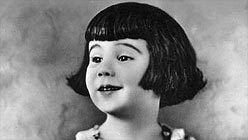Diana Serra Cary probably can’t help with your complicated feelings about Lindsay Lohan and Dakota Fanning. But Cary, born Peggy-Jean Montgomery in 1918, certainly can offer some perspective on the peculiar, glamorous, exploitative, glorious, horrifying phenomenon of child stardom (not to mention the related topic of wackjob showbiz parentdom). She was one of its inventors.
If you think today’s movies are infantilizing, get a load of Baby Peggy. Get a load of her this weekend, actually, in person, at the Niles Essanay Silent Film Museum’s Baby Peggy 90th Birthday Bash, a two-day extravaganza with features, shorts, a documentary, an interactive panel discussion and a book signing.
One obvious benefit of Cary’s nine decades’ worth of hindsight is that her movie-industry reflections have been finely honed. “It was hard work,” she told London’s Independent in 2006. “I did my own stunts. They thought children were made of rubber then.”
In Baby Peggy’s many films, the cherubic, almond-eyed tot often proved savvier about matters of adulthood than the grownups surrounding her. A talented mimic, she also specialized in eerily accurate miniature parody versions of older stars like Mary Pickford and Pola Negri. And she inspired a line of dolls in her own image.
Baby Peggy got started by accident when her mother brought the 19-month-old to watch a movie being made at Century Studios, told her to sit quietly on a stool in the corner, and was commended for having such a well-behaved child by the director — who happened to need a tyke to star in his next project, opposite Brownie the Wonder Dog. When that movie, Playmates, scored big, Peggy scored a contract. Her cowboy-stuntman-actor father took it from there, and the rest is — well, a forgotten cautionary tale of ’20s Hollywood.


